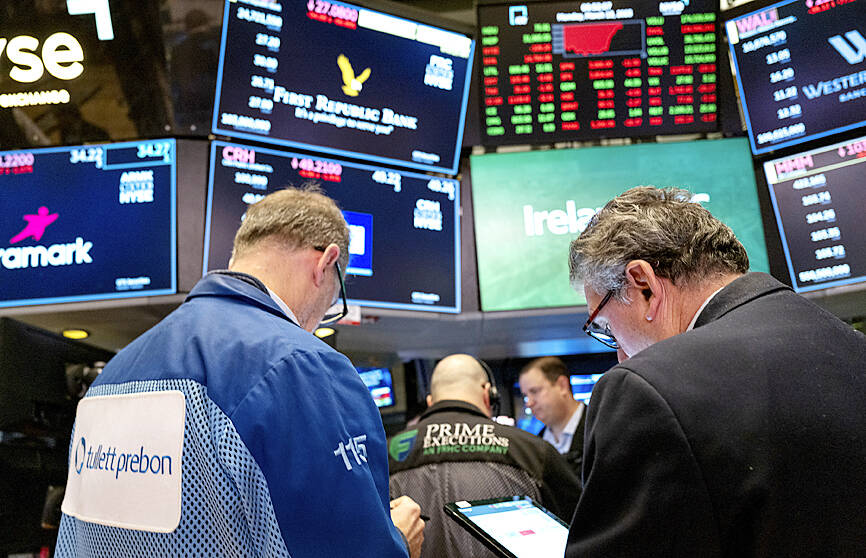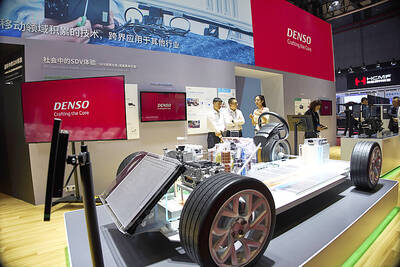The global market for initial public offerings (IPOs) is showing signs of life as a rebound in the stock market has emboldened companies to test investor appetite for new listings, particularly in Asia.
However, a full-fledged recovery looks distant.
IPOs totaling about US$25 billion were launched last month and this month, nearly twice the amount seen in the first two months of the year, when listings virtually ground to a halt.

Photo: AP
Issuers from Hong Kong to Italy saw a window of opportunity with the decline in market volatility, analysts said.
Activity was particularly buoyant in Asia, where regional exchanges accounted for nearly 80 percent of new share sales this month. Listings in Europe also picked up.
However, concern about a recession has deterred US issuers, slowing a full-fledged recovery. Average deal sizes were smaller, and the money raised so far this year remains 51 percent below the same period last year.
“We are beginning to see green shoots of activity with companies restarting processes that were on hold, but there is still a fair degree of uncertainty in the market,” said Jason Manketo, global cohead of law firm Linklaters LLP’s equities practice. “The buy side is keen to see results for a couple of quarters before committing to an IPO. This means the potential pipeline of some 2023 deals has been moved out to 2024.”
Drilling down into the data, Asia is handily the busiest area for offerings in the world right now, but in a key change compared with last year — when the vast majority of large deals were concentrated in China — issuance is coming from a broader swath of Asia this year.
Indonesia has been the brightest spot with a pair of nickel producers surging in their debut.
Rakuten Bank Ltd soared after raising ¥83.3 billion (US$620.9 million) in Japan’s largest IPO since 2018 — although, the pop came after the initial price range had been cut.
KKR & Co-backed Chinese liquor company ZJLD Group Inc (珍酒李渡集團) on Thursday priced Hong Kong’s largest offering this year.
“The IPO market is coming back gradually and slowly. It is not 100 percent back yet, but there are signs of life and renewed vigor,” said James Wang (王亞軍), cohead of equity capital markets at Goldman Sachs Group Inc in Asia excluding Japan.
Europe’s IPO market has been moribund, with this year’s activity down about 12 percent from the same period last year, when Russia’s invasion of Ukraine brought listings to a screeching halt.
Poor IPO returns have been a major deterrent for investors. Portfolio managers have been driving hard bargains on valuations and refusing to pay top dollar for new, unproven companies.
Meanwhile, the sudden meltdown of Credit Suisse Group AG, which ignited a global market rout last month, has added to investor worries about interest rates and inflation, further muddying listing plans.
However, there have been signs of gloom lifting. Most notably, Lottomatica SpA, an Italian gambling company backed by Apollo Global Management Inc, opened books last week for a 600 million euro (US$665.8 million) IPO, becoming the third large firm to tap European exchanges this year.
Additionally, German Web-hosting company Ionos SE and electric motor component maker EuroGroup Laminations SpA have each raised more than US$400 million, although both stocks have struggled after debuting.
Still, the outlook for IPOs in the US remains challenged. Only US$4.1 billion has been raised for companies listing on US exchanges this year, with just three — Nextracker Inc, Atlas Energy Solutions Inc and Enlight Renewable Energy Ltd — accounting for one-third of that amount.
Outside that cluster and a dozen special purpose acquisition companies that have debuted this year, the vast majority of new listings would be qualified as penny stocks.
“We’re still in an uncertain world and uncertainty is the worst thing for new issuances,” Rainmaker Securities LLC cofounder Greg Martin said.

GROWING OWINGS: While Luxembourg and China swapped the top three spots, the US continued to be the largest exposure for Taiwan for the 41st consecutive quarter The US remained the largest debtor nation to Taiwan’s banking sector for the 41st consecutive quarter at the end of September, after local banks’ exposure to the US market rose more than 2 percent from three months earlier, the central bank said. Exposure to the US increased to US$198.896 billion, up US$4.026 billion, or 2.07 percent, from US$194.87 billion in the previous quarter, data released by the central bank showed on Friday. Of the increase, about US$1.4 billion came from banks’ investments in securitized products and interbank loans in the US, while another US$2.6 billion stemmed from trust assets, including mutual funds,

Micron Memory Taiwan Co (台灣美光), a subsidiary of US memorychip maker Micron Technology Inc, has been granted a NT$4.7 billion (US$149.5 million) subsidy under the Ministry of Economic Affairs A+ Corporate Innovation and R&D Enhancement program, the ministry said yesterday. The US memorychip maker’s program aims to back the development of high-performance and high-bandwidth memory chips with a total budget of NT$11.75 billion, the ministry said. Aside from the government funding, Micron is to inject the remaining investment of NT$7.06 billion as the company applied to participate the government’s Global Innovation Partnership Program to deepen technology cooperation, a ministry official told the

Taiwan Semiconductor Manufacturing Co (TSMC, 台積電), the world’s leading advanced chipmaker, officially began volume production of its 2-nanometer chips in the fourth quarter of this year, according to a recent update on the company’s Web site. The low-key announcement confirms that TSMC, the go-to chipmaker for artificial intelligence (AI) hardware providers Nvidia Corp and iPhone maker Apple Inc, met its original roadmap for the next-generation technology. Production is currently centered at Fab 22 in Kaohsiung, utilizing the company’s first-generation nanosheet transistor technology. The new architecture achieves “full-node strides in performance and power consumption,” TSMC said. The company described the 2nm process as

JOINT EFFORTS: MediaTek would partner with Denso to develop custom chips to support the car-part specialist company’s driver-assist systems in an expanding market MediaTek Inc (聯發科), the world’s largest mobile phone chip designer, yesterday said it is working closely with Japan’s Denso Corp to build a custom automotive system-on-chip (SoC) solution tailored for advanced driver-assistance systems and cockpit systems, adding another customer to its new application-specific IC (ASIC) business. This effort merges Denso’s automotive-grade safety expertise and deep vehicle integration with MediaTek’s technologies cultivated through the development of Media- Tek’s Dimensity AX, leveraging efficient, high-performance SoCs and artificial intelligence (AI) capabilities to offer a scalable, production-ready platform for next-generation driver assistance, the company said in a statement yesterday. “Through this collaboration, we are bringing two